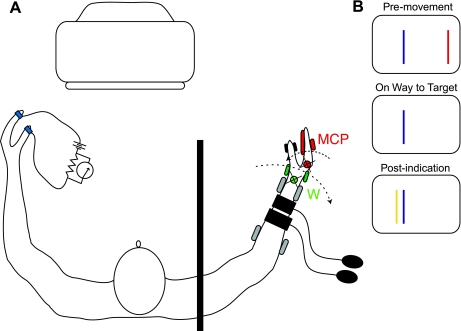Fig. 1.
Experimental setup. A: top-down view with the subject sitting at the limb-motion device. Two motors apply movement independently to the hand, one at the wrist (green) and the other at the fingers (red). Two sphygmomometer cuffs are applied to the right forearm and a contact device to the left thumb and index finger. An opaque shield (vertical black bar) prevented the subject from seeing the right arm. A computer monitor provided visual feedback. B: graphical presentation of constant error (CE) at 3 points during a trial; red line denotes the MCP starting position, blue line denotes the target angle, and yellow line denotes the metacarpophalangeal (MCP) angle at which the subject indicated target arrival, in this example resulting in a small overshoot. The distance from the red line to the blue line is equivalent to 12 degrees of MCP flexion.

